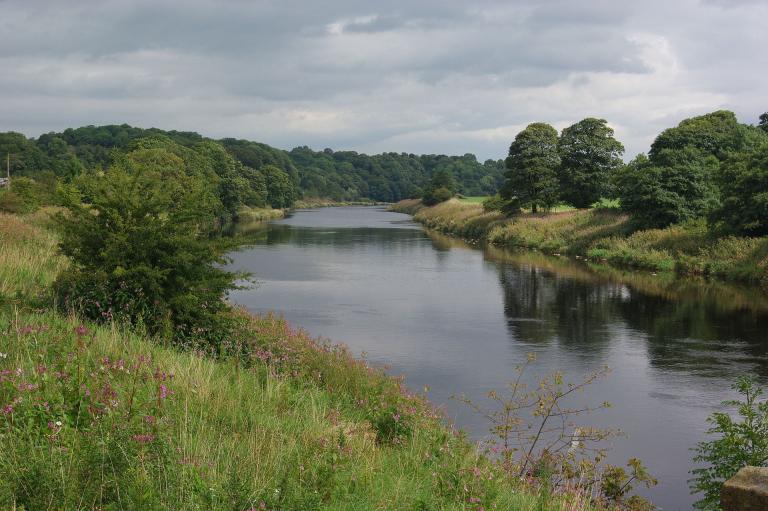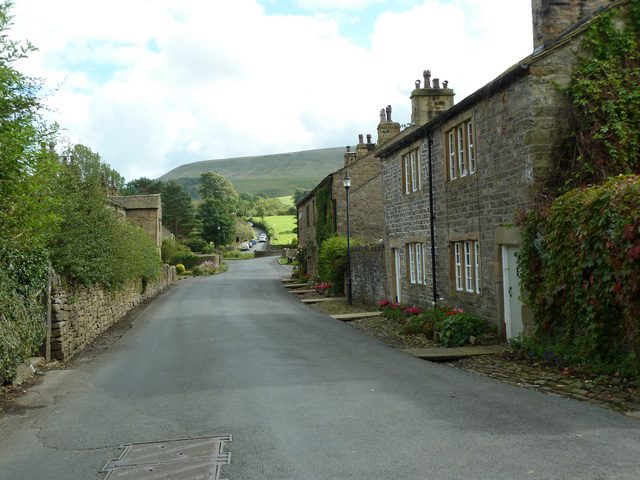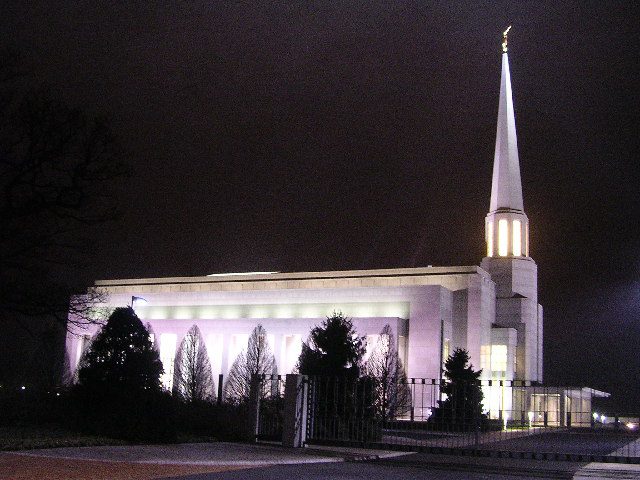
(Wikimedia Commons public domain image)
We landed at Liverpool this morning, where we were met by Peter Fagg, who is, to my knowledge, far and away the premiere Latter-day Saint tour guide in the United Kingdom. First, we walked about the dock area in Liverpool where the first missionaries to England, led by Elder Heber C. Kimball of the Quorum of the Twelve Apostles, arrived in 1837. This is also the port from which most British emigrants to America left in the nineteenth and early twentieth centuries, and a nice life-size sculpture of a Latter-day Saint emigrant family stands there.
Then we drove to Preston, where the missionaries had their first significant success and where the oldest historically-continuous congregation of the Church of Jesus Christ of Latter-day Saints — the Preston Ward — still meets. We looked about in Preston, including the market square where the missionaries used to preach and the house on the corner of Fox Street and St. Wilfrid Street, not far away, where they first lodged. It’s empty and derelict, but it’s still standing — and if I had the money to do so I would buy it. Why? Because there’s a truly remarkable story behind it — see Peter Fagg’s article “A Satanic Attack on the First Missionaries in Preston, England” — and because I’m afraid that it will be demolished if somebody doesn’t step in to save it fairly soon. Then we walked over to Avenham Park, a beautiful green area of trees and grass that runs along the River Ribble, where the very first Latter-day Saint baptisms in Great Britain were performed. Several plaques in the park commemorate the early missionaries and the effects of their work.
We then drove up the Ribble Valley, through the town of Chatburn to the village of Downham. Elder Kimball was told to bother with neither village, because the people in them were irreligious and godless. He went anyway and had phenomenal success. (This is one of the stories that I hope we can cover, to at least some extent, in the docudrama portion of Six Days in August.)

(Wikimedia Commons public domain image)
For now, though, I want to concentrate on another aspect of this particular episode: In April 1838, Elder Kimball was about to return to America, so he came back for a farewell visit to Downham and Chatburn. Their response moved him deeply:
When I left them, my feelings were such as I cannot describe. As I walked down the street I was followed by numbers: the doors were crowded by the inmates of the houses to bid me farewell, who could only give vent to their grief in sobs and broken accents. While contemplating this scene I was constrained to take off my hat, for I felt as if the place was holy ground. The Spirit of the Lord rested down upon me and I was constrained to bless that whole region of country.
Joseph Fielding was also there with Elder Kimball:
It was very affecting to witness our Parting with them. The Streets were almost lined with them weeping and looking after us. Brother K. [Kimball] left his Blessing on them and the Whole place, walking with his hat off. They all followed us with their Eyes as far as they could see us, many of those even that had not been baptized.
Elder Orson Hyde recalled the experience in the October 1853 General Conference of the Church of Jesus Christ of Latter-day Saints:
What were our feelings? We felt that the ground upon which we stood was most sacred, and brother Kimball took off his hat, and walked the streets, and blessed the country and the people, and let his peace come upon it. Why? Because the people were ready to receive the word of our testimony, and us for Christ’s sake.
In 1857, Elder Kimball again remembered that farewell visit:
I went through the streets of that town feeling as I never before felt in my life. My hair would rise on my head as I walked through the streets, and I did not then know what was the matter with me.
I felt as if my whole system was alive; I felt quickened by some unseen power.
When Elder Kimball returned to America in 1838, he related his experience in Downham and Chatburn to the Prophet Joseph Smith, whose response was intriguing:
Did you not understand it? That is a place where some of the old prophets travelled and dedicated that land, and their blessing fell upon you.
Let me try, very briefly, to lay out a bit of curious background concerning the area:
Downham sits at the base of Pendle Hill, which remains famous for the 1612 trial of the Pendle witches. That’s certainly worthy of note, but it’s not even remotely the full story.
One day, in (I believe) 1652), George Fox climbed up Pendle Hill and saw what seems to have been a vision of “a people in white raiment, coming to the Lord,” a “great people to be gathered.” This event, and George Fox’s reaction to it, led to the founding of the so-called Society of Friends, which is better known to most people as Quakerism. John Wesley (1703-1791), the founder of Methodism (which he never intended to be a distinct denomination), also visited Pendle Hill and felt himself exceptionally moved, spiritually, as he worked in the villages and among the people at its base.
(See Peter Fagg’s “Ribble Valley — Sacred Pendle Hill.”)
So Heber C. Kimball may not have been merely imagining things when he “felt as if the place was holy ground.” Even early seventeenth-century the suspicions of witchcraft seem rather appropriate: Satan always seems to make a grand appearance before a new dispensation (e.g., at Moses 1, in the Judaean desert after Christ’s baptism, and just prior to Joseph Smith’s First Vision).

Leaving Downham, we drove to the Preston England Temple, which is striking and which sits amidst beautiful grounds and gardens and a complex of other Church buildings. When Elder Jeffrey R. Holland was the area president for the United Kingdom, he went into the woods near Downham to pray about where the temple should stand, and he was inspired to recommend the site where, in fact, it does now stand.
Posted from the Irish Sea












